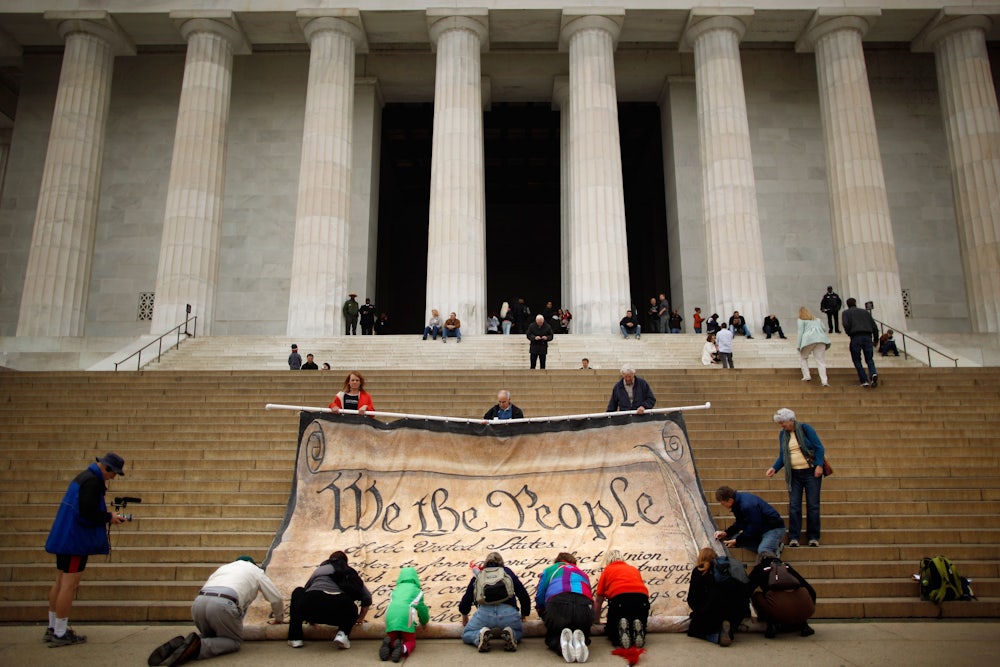As the Supreme Court deliberated on Monday over the legality of race-conscious college admissions, Justice Elena Kagan gave voice to a patriotic skepticism: “I thought that part of what it meant to be an American and to believe in American pluralism is that actually our institutions are reflective of who we are as a people in all our variety.” While affirmative action in college admissions may go by the wayside now that such matters are entirely tied to the whims of the high court’s conservative supermajority, Kagan managed to illuminate an underappreciated truth about constitutional interpretation: How we choose to interpret our founding legal document reflects and shapes who we are as a people—and who we want to be.
In the cases before the court, Students for Fair Admissions v. UNC and Students for Fair Admissions v. Harvard, the petitioners claim that the admissions policies at Harvard and University of North Carolina are unsupported by the Fourteenth Amendment’s original meaning. This exposes two competing visions for our country. We can preserve a stratified society by viewing the Constitution as an obstacle that categorically constrains race-conscious remedial policies, or we can see the Constitution for what it really is: a document that fully embraces multiracial democracy and actively facilitates its existence.
The far right has leaned in to one theory of constitutional interpretation—originalism—as a weapon against disfavored communities. But an alternative mode of legal thought could consciously protect against rights violations and affirmatively reshape the law. I propose that we adopt a new framework, which I call “inclusive constitutionalism.” In the affirmative action cases and beyond, legal interpretation ought to be guided by the expansive principles of the Reconstruction Amendments and their unfinished mission to foster a democratic society with equal membership for all.
This guiding light has been all but extinguished by the warped federal judiciary. The rationale the court seems prepared to accept in these affirmative action cases threatens far more than a mere change to college admissions policies. Left uncountered, it will erase decades of racial progress in educational opportunities and hamstring a wide battery of legislation enacted to quell racial discrimination. Crucially, the Constitution, Supreme Court precedent, and common sense all dictate that you may consider race to repair a harm that was inflicted along racial lines. But the cases currently before the Supreme Court eschew both logic and law. Instead, the petitioners are transparently swapping out the goals of the Constitution for the goals of the conservative legal movement.
The principal target of the Reconstruction Amendments was the sociopolitical status of Black people in America. At the time of their ratification, the Civil War had been won and slavery was ostensibly over, but subjugation persisted. The government correctly recognized that its work was far from finished. Rather, it recognized that it had a duty to “see that the gulf that separates servitude from freedom is bridged over’’ and ensure that Black people were welcomed into equal citizenship. Reconstruction-era legislation like the Fourteenth Amendment was explicitly designed to better weave Black people into the fabric of America, including by extending political power to formerly enslaved people, curtailing the political power of insurrectionists who sought to defend slavery, prohibiting states from denying any person equal protection of laws, and authorizing Congress to legislatively enforce these provisions.
The Constitution’s power comes from the recognition that liberty, equality, and justice are abstract concepts that must be made real in a democratic society through law and policy. The allegation made by opponents of affirmative action that UNC and Harvard consider race in order to “advance their social-engineering agenda” ignores the fact that the Constitution does the same thing. Its deliberate efforts to end race-based subordination and confer meaningful rights and protections to Black people mean the Constitution itself is a race-conscious remedy. Arguments that race-conscious remedies are by definition unconstitutional are preposterous on their face.
Petitioners contend that the driving principle of the Fourteenth Amendment is simple neutrality. They told the court on Monday that race neutrality means “racial classification” cannot “have any role to play in providing educational opportunities” and the “view that the educational benefits of diversity justify racial classifications contradicts the Fourteenth Amendment’s guarantee of equal treatment.” This framing presents the mere classification of racial groups as the core discrimination issue that the Constitution must address. Unsurprisingly, the petitioners’ simplistic statement of the problem warrants a simplistic solution: ignore that these different groupings exist.
Naturally, there’s one small problem with this idea: These groupings exist regardless of any institutional desire to wish them away. And a reductive focus on whether racial classifications are acknowledged obscures much more important questions, such as, will acknowledging them advance or undermine equal opportunity? Would this help or hurt a multiracial democratic society? Does this align with the principles and goals the Constitution is supposed to achieve? The strict, so-called “color-blind” approach favored by the conservative legal movement doesn’t provide satisfying answers to these questions; the obvious consequence of ignoring race is ignoring racism.
The Supreme Court knows this—the court recognized in Grutter v. Bollinger that while students of color are likely to have personal experiences that are particularly important to the educational mission of colleges and universities, they are less likely to be admitted in meaningful numbers on criteria that ignore those experiences “by virtue of our Nation’s struggle with racial inequality.” Nevertheless, prevailing models of legal interpretation contend that remedying racial subordination is impermissible because doing so takes race into account. This reasoning isolates the Fourteenth Amendment from its rich historical context and moral imperative. Untethering the Constitution from the realities of discrimination and efforts to combat oppression has a cruelly ironic result: The Fourteenth Amendment is thus dragooned against its will to preserve a white supremacist status quo rather than dismantle it, as it was intended to do.
This misreading underlies petitioners’ characterization of measures to incorporate deliberately excluded communities as unnecessary racial preferences. But society need not surrender to poor comprehension and moral illiteracy. The Constitution should be read as empowering us to build a more inclusive democracy rather than artificially constraining us from responding to the reality of racism and other persistent forms of oppression. Part of what it means to be an American, to return to Kagan’s earlier rumination, is a belief in self-governance. And part of self-governance means we have the opportunity to decide what the Constitution means to us.
Liberals should be thinking more creatively about countering the theories of the conservative legal movement—which are increasingly divorced from the “originalist” ideas it once claimed to uphold—with countermeasures that draw on the ideals of our founding documents. Championing the idea of inclusive constitutionalism, and making the forceful argument that the post–Civil War amendments fundamentally transformed the Constitution into a tool for building a functioning multiracial democracy central to legal interpretation, is just one powerful argument that can be brought to bear against a wayward Supreme Court.










